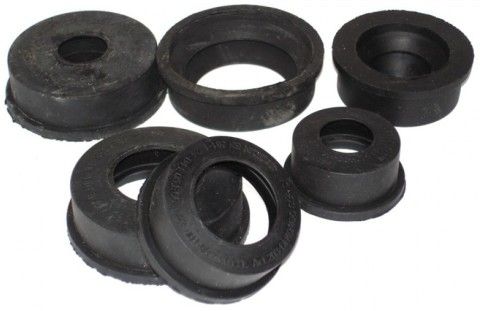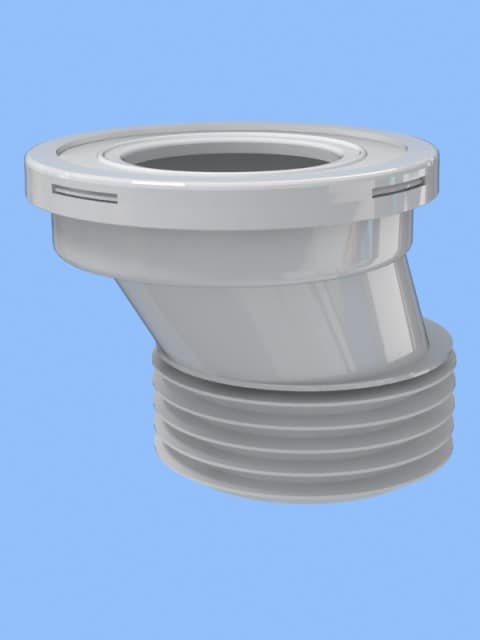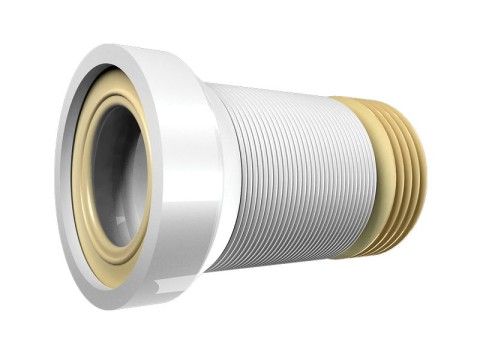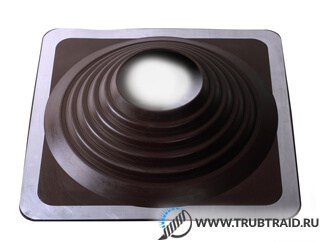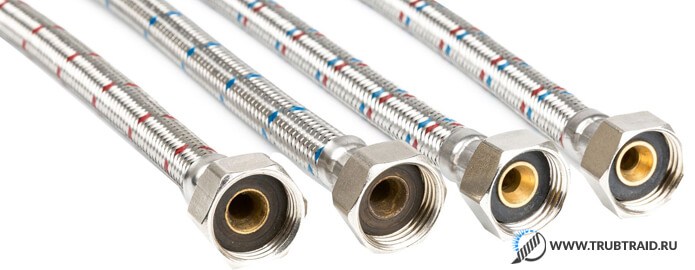Sealing with rubber cuffs
Rubber seals for sewer pipes are most often used. They are easy to use, reliable and durable. They are used when installing sewerage in country houses and apartments, industrial buildings. The composition of rubber seals includes the following substances:
- rubber compound;
- rubber;
- polyurethane;
- silicone;
- paronite.
The result is strong, elastic rubber seals that provide tightness and reliability of sewer pipe connections. Products resistant to temperature extremes, aggressive chemicals, non-concentrated acids and alkalis.
Rubber seals are classified according to their purpose. They can be universal, rod, piston. Three-blade seals provide a smooth transition from a cast-iron pipe to a plastic one.
Rubber cuffs have a number of advantages. They are inexpensive, reliable, durable, prevent the penetration of groundwater into the sewer. Thanks to the compactor, the drains do not have an outlet to the outside, and an unpleasant odor does not arise on the territory.
Cuff Practice
With the help of cuffs, plumbing equipment (sinks, sinks, bathtubs, toilet bowls, etc.) and household appliances (washing machines, dishwashers) are connected to the sewer network, sewer pipes are connected. Plastic is connected to plastic by means of special fittings equipped with sealing rubber rings, and cast iron is connected to plastic either with adapters, or couplings, or only cuffs.
Both external and internal cuffs are used for joining cast-iron and plastic pipes (for socket and socketless structures). Work in stages:
- they clean the connecting part of the cast-iron pipe - it must be absolutely clean to ensure proper adhesion of the sealant;
- apply sealant to the cuff and insert it into the socket;
- a plastic tube is inserted into the cuff.
If pipes have to be cut, this must be done correctly - the cut must be even (no notches, even if they seem microscopic and are difficult to detect). Having cut off, a chamfer is removed from the part.
In order of action, the docking of smooth pipes is not much different from socket pipes - the sealant must be applied to the cuff on both sides, since a coupling is put on top of it.
Scheme of installing a cuff on a sewer pipe (connection of smooth pipes)
Siphon connection
For this purpose, the use of a sealing cuff is mandatory (there is always water in the siphon - it serves as a kind of shutter). There are no difficulties in connecting the siphon - it is quite possible to cope on your own without having special knowledge. First, the siphon itself is assembled - according to the instructions (the accompanying documentation must be available, otherwise you should not buy equipment: the configuration is different, and the assembly instructions vary accordingly). Then connect the pipe:
- to the siphon
- to the sewer (simply inserted into the fitting hole intended for this).
If the fitting on the riser is equipped with an o-ring, the cuff is used only to connect the pipe to the siphon.
What is needed for the organization of internal sewage
Internal sewerage collects wastewater from around the house and dumps it into the riser.
Sewer accessories include:
- hydraulic seals connecting plumbing fixtures to the pipeline;
- a pipeline that discharges drains from a floor into a collector;
- ventilation tube;
- actually, the riser itself;
- sewer lounger - a horizontal section of the pipeline, through which effluents enter further from the riser.
When laying pipes, you will need such shaped elements as revision, tees, elbows, plugs, etc.e. Without them, it is impossible to ensure the removal of wastewater in accordance with all the rules.
Shaped elements
Fittings for sewerage can otherwise be called connecting parts, they are available in the following configurations:
clutch
- a short piece of pipe with sockets on both sides. It is used for connection of 2 parts of the pipeline;
adapter
(reduction) - used to connect pipes of different diameters. The reduction can be coaxial, eccentric;
tee
- this element is indispensable in situations where you need to create a branch that extends from the main sewer, for example, when wiring the floors with your own hands;
revision
- the same tee, only the outlet is closed with a plug, and the branch itself is small. It is used when the sewer is clogged to clean it;
cross
- the purpose is the same as that of the tee, but with its help a more complex knot is organized;
-
knee
(bend) - used when turning the pipeline; -
check valve
- necessary in emergency situations, thanks to it, wastewater will not flow back in the event of a malfunction of the drainage system;
plug
- during repairs it is used to block the sewer.
The sewer cut is a vital element when laying the system. Without them, it is impossible to carry out either the distribution of pipes along the floor or their connection to the riser.
Features of connecting plumbing fixtures
The connection of any plumbing fixture must be organized so that unpleasant odors from the sewer do not leak into the room. The simplest way is to connect through a water seal (or siphon).
The siphon looks like an ordinary pipe in the shape of the letter S, thanks to the water plug, odor protection is guaranteed. If regular residence is not planned in the house, for example, in the country, then other ways to protect against odors (dry sewer siphon) can be considered.
Sewer repair
When repairing the above items will not be enough. In particular, when replacing a pipeline section, sewer pipes will be needed.
It is not uncommon for a part of the old pipe to rot or simply crack, in which case it will not be necessary to replace the entire drainage system, but only a small section. In order to connect a new pipe to an existing drainage system, branch pipes are used.
Outwardly, the sewer pipe looks like a small piece of pipe, on the one hand it is smooth, and on the other - a socket. Accordingly, on the one hand, the connection is made in a socket way, on the other - in a joint, using a coupling.
Sometimes when repairing an old cast-iron sewer, you have to join plastic and cast-iron pipes. At the same time, one sealant is not enough to achieve the required tightness. First, you will need to insert a rubber cuff into the cast-iron socket and already into it - a plastic pipe.
Tightness of the junction of plumbing fixtures and pipelines
A sewer seal is used to reduce the likelihood of leaks in the area between the plumbing fixture and the pipeline. Externally, the cuff looks like a rubber ring that is put on over the joint.
To achieve greater elasticity, the cuffs do not contain polymers, only natural rubber is used for their production. True, during operation, because of this, it is necessary to use lubricant so that the rubber does not crack.
If you plan to use a rubber cuff, then you will also need a lubricant for sewer pipes. If you try to insert the end of the pipe into the cuff without lubrication, then the rubber can be easily damaged. And after installation, the cuff must be periodically lubricated.
As for the specific lubricant, there are many options, some prefer to use automotive lubricant, which is used for rubber inserts in car doors in winter.But the usual plumbing grease allows you to keep the rubber safe and sound.
How to seal pipes
Rubber
sealant for sewer pipes is used most often. The sequence of installation work depends on whether the internal or external sewage system is installed. When arranging an internal pipeline, installation consists of the following steps:
The connection is sealed, the pipeline is now ready for operation. It should be remembered that if silicone sealant is used, it should not be applied to the outside of the sewer pipe.
If sealing of the external pipeline is required, installation work is carried out in the following sequence:
- the sealing composition is applied to the inner surface of the rubber cuff;
- the fitting is put on the branch pipe;
- when the sealant hardens, the pipeline can be connected.
Sealing the connections of sewer pipes is an important step in the performance of installation work on the installation of sewers. It is at the joints that blockages, leaks and other unpleasant problems most often form, contributing to a reduction in the operational life of the sewer system. You can prevent any problems if you follow the advice of professionals, carefully and diligently perform all the work.
In order for the sewer system to function efficiently and efficiently, it must be properly installed. It is easier for residents of multi-storey buildings that install only an internal pipeline. But the owners of country mansions will have to take care of laying an external sewage system and arranging an autonomous system.
Sewerage installation consists of several stages:
- drafting a sewer system;
- purchase of materials;
- pipe connection;
- joint sealing;
- sealing connections.
Sealing of sewer pipes is necessary to avoid leaks and breakthroughs during the operation of the system. Most often, rubber cuffs are used to seal the joints of plastic sewer pipes. Seals prevent water from getting in or out, protect the sewer from the penetration of insects and small rodents. Qualitatively sealed connections are a guarantee of long-term and efficient functioning of the sewer system.
What are the cuffs for sewer pipes
This is predominantly a round wide sealing ring, sometimes with a corrugated part. Cuffs are internal and external. The internal ones are used to connect socket structures, the external ones are used for smooth pipes (in addition to the sealant, a coupling is installed).
Sealing cuffs with corrugated part
Cuffs are most often made of rubber - an elastic material that tightly adjoins, providing a reliable flexible connection. The shape of a part depends on its function.
Rubber cuffs
Eccentric cuff
The eccentric cuff is a branch pipe connected to each other with an offset, that is, the centers of both parts are in different planes. Traditionally, the part is called a cuff, but this is a special shaped part for connecting to the toilet network. It is equipped with O-rings and does not require the use of sealant (with the exception of connecting to an old cast iron riser, when sealant is used for greater reliability, given the difference in materials).
Unfortunately, due to too much displacement of the connected elements, the eccentric cuff cannot always be used (although some craftsmen manage to insert one into the other, building a strange design) - in such cases, the toilet is connected by means of a corrugation.
Eccentric cuff
Parts come in different configurations, but sometimes such an offset is required that it is impossible to connect with their help - in such cases, a corrugation is installed.
Corrugated cuff
The corrugation is similar to the eccentric cuff, but the implementation of the displacement is different - it is achieved due to the flexible corrugated sleeve, and not the location of the parts relative to each other. Thus, the displacement can be large, but it is necessary to set the desired bending angle of the corrugated part so that the drains leave freely (otherwise blockages are inevitable).
Connection via corrugation
The main advantage of corrugations is flexibility. Due to this property of the part, it is almost always possible to connect the toilet to the sewer without errors. The main disadvantage is the short service life. Due to the same flexibility, the walls quickly wear out, and the part becomes unusable. When choosing a corrugation, you need to give preference to thick-walled, reinforced.
Reinforced corrugation
Installation is theoretically simple (the parts are tritely inserted into each other according to the attached instructions), but we do not recommend installing it yourself (if there are no skills): the cuff functions normally under certain conditions (bending angle, slope, stretching length), and if they are not created, the system will work will be violated (which is fraught with floods due to blockages).
So reading a newspaper / memoirs, sitting on the toilet, occasionally looking out the window, will not succeed - or you will have to erect a plumbing miracle on a pedestal and screw a ladder to it (here it’s not far from the attic window).
On a pedestal
This problem also has a solution - the installation of a pumping system that forcibly sends wastewater to the sewer. However, such drastic changes will require permission to redevelop, and these are:
- project development (yes, just to move the toilet a meter);
- project payment;
- its coordination in the instance and everything connected with it;
- payment of a fee for approval;
- the commission that accepts the transfer of equipment (they look at how far they have departed from the project, if they have departed);
- payment of a fee for a commission.
We recommend using cuffs exclusively for their intended purpose - for connection and no more.
Everything is easy in the text - the text cannot convey the effort being made. However, we all know what is transported by sewer pipes (that is, what will flood the apartment / house when incorrectly installed cuffs cause a flood), and therefore, when it comes to sewage, we strongly recommend that even owners of restless hands turn to specialists
Especially when it comes to cast iron risers: cast iron is brittle and must be handled with extreme care.
How to correctly install the cuff
The easiest way is to connect a corrugated pipe with a plastic riser. This is due to the specifics of such a joint: it is quite easy to insert an elastic band into the socket, after which the tip of the flexible pipes is placed in the hole.
A more complicated option is to connect a plastic riser with a cast iron one. This is due to the fact that for a high-quality joint, it is necessary, in practice, to perfectly clean the cast-iron socket from old sealant residues and other possible contaminants.
It is not particularly difficult to join the sewer section of pipes with the presence of internal sealing cuffs.
The uncut type pipe lug easily and easily penetrates into the flared area, in which the seal must first be placed correctly. When the section of the highway is cut off, then at its end it is necessary to make an edge under the cone, after which the elastic band will easily take its place. Plain water can be used as a lubricant.
Risers with a diameter of 110 mm (it is best to buy manufactured by Rossiya) are more difficult to connect, even if the docking point is moistened with water. Therefore, to facilitate the installation of the connecting cuff, it must be lubricated with automotive oil, other improvised lubricants that will facilitate the installation process.
Differential pressure regulator valves can be installed similarly.
Since our building stores have a sufficient number of connecting transition cuffs for metal, polypropylene, plastic, it is not particularly difficult to hermetically assemble the pipeline. You just need to correctly determine the internal diameters. After that, docking cast iron with plastic, plastic with plastic or other docking will not be a problem.
Sewer rubber cuffs can be made from different materials, there are also different types of devices. Hydraulic seals are used in industry, for equipping a sewage system in private houses, cottages and apartments.
Cuffs for cast iron sewers are made of polyurethane and rubber compounds such as rubber, paronite, silicone and rubber. In the manufacture, only 100% rubber is used, no polymer is added. Thanks to this composition, high elasticity, strength and tightness of fastening with the connected parts are ensured. Polymer and rubber also provide resistance to high and low temperatures, are resistant to aggressive substances, can be used in the presence of acids and with increased rigidity of working resources.
The sealing cuff for sewerage also comes in various types:
- stock;
- piston;
- universal (for rods and pistons).
Also, the sealing rubber cuff for sewerage can be internal and external. An internal seal is used in cast iron pipes to connect plastic pipes with different diameters. Also used to connect a corrugated hose to the drain of household plumbing fixtures (for example, connecting to the sewage system of a washing machine or dishwasher). The outer seal, in turn, is used to connect to a socketless sewer structure.
There is also a three-lobed sewer transitional cuff, which facilitates the transition from a cast-iron pipeline to a plastic one.
Elements of external sewage
In addition to the pipes themselves, revisions and elbows, the outer section of the sewage disposal system includes several specific elements. In the case of an autonomous sewer, effluents need to be stored somewhere while they are being cleaned, so you will need to build a sump, or better, a septic tank.
Sump construction
Sumps for sewerage are a conventional pit in which wastewater settles, large particles settle to the bottom, after which the clarified wastewater passes to the next stage of treatment. Outwardly, the sump looks like a pit with reinforced walls and a bottom (or a special container).
If the sump is built independently, then the instruction looks like this:
- a hole is dug in the ground (depth is about 2.5 m, section is at least 2.0x2.0);
- a pillow from a layer of gravel is poured to the bottom of the pit, on top of which a sand layer is arranged;
- after that, you need to seal the bottom and walls of the pit. It is possible to build a formwork, place a reinforcing cage in the pit and fill the walls and bottom of the pit with a concrete mixture, it is allowed to strengthen the walls with brickwork;
when the concrete hardens, all that remains is to concrete the ceiling and arrange the ventilation of the sump.
You can go the other way, many people use large-volume plastic containers instead of time-consuming concreting for sedimentation tanks. These can be eurocubes, plastic barrels, metal barrels in which paintwork materials were previously stored. The price of the sump device in this case is low, but tightness is ensured.
There are also budget options for sedimentation tanks. From ordinary tires for a truck, you can build a sump suitable for irregularly used sewers.
Tanks for septic tanks stand apart.Outwardly, such a container looks like a large barrel with ventilation pipes, and the internal space is divided into separate zones: first, the drains settle, then the liquid enters the second section through the overflow system, where the final cleaning takes place.
Fluoroplastic pipes and barrels for sewerage
Separately, it is worth mentioning fluoroplastic barrels for sewerage. PTFE itself is an interesting material. Pipes and barrels from it can be operated in the temperature range from -100ᵒС to +250ᵒС. In addition, PTFE is strong and durable.
Note! Fluoroplastic is an inert material, it does not react even with very aggressive substances, in this indicator it even surpasses platinum and gold. Therefore, it is not entirely justified to use it in a conventional sewer.
Most often, fluoroplastic pipes and barrels are used in the chemical industry.
Pros and cons of cuffs
The sealing rubber cuff for the sewerage 100 has a number of advantages.
It is characterized by:
- reliability, which eliminates the possibility of leakage of water from the sewer line, since plastic can be perfectly fixed in a cast-iron pipe;
- the ability to withstand sudden pressure drops ranging from 50 to 150 kPa;
- breadth of the range. Since hydraulic seals come in different diameters, they can also be used to articulate risers of different diameters;
- budget. The price of seals is so low that it is completely affordable for an ordinary citizen.
The negative sides include the fact that in order to mount the cuff in the right place it is necessary:
- the presence of sockets at the ends of cast-iron pipes;
- bring the inner surface to an almost perfectly even and smooth.
The sealing cuff is necessary when connecting the siphon to the sewer system. It must be remembered that you should first start collecting the siphon itself, and only after that - connecting the device to the line.
Properties of sealing elements and materials of manufacture
For sealing to be effective, cuffs must have the following properties:
- elasticity;
- elasticity;
- the ability to withstand temperature changes within certain limits;
- strength and long service life.
These properties are fully possessed by rubber products, therefore, sealing sleeves and cuffs for sewage pipes and transitional fittings are made by varieties of this material, such as:
- actually rubber;
- paronite;
- rubber;
- silicone.
Sometimes manufacturers add polymeric substances to the rubber composition, which makes sealing gum for sewer pipes more rigid, less convenient during installation work, but at the same time wear-resistant and durable.
Some types of cuffs, for example, those equipped with adapters for connecting the toilet drain to the sewer pipe, are made of polyethylene. In conditions of a large diameter of the connected holes (at least 110 mm) of often irregular geometry, this material demonstrates better tightness and wear resistance (rubber cuffs have to be replaced with similar ones after dismantling).
About bellows connections for mixers
Flexible hose to the mixers has different options. One of the most popular is the bellows type. It has a number of advantages in comparison with other similar devices.
4.1. Advantages
Among the many positive characteristics, we can distinguish the following:
- made of high quality stainless steel;
- reliably protected from water hammer;
- high-quality operation is possible for a long time;
- resistant to possible sharp temperature fluctuations, can fully function at temperatures up to 230-250⁰C;
- hygienically clean, safe for health, device;
- does not burn.
4.2. Flaws
There are several negative points associated with the use of bellows liner:
- the appearance of hum, noise, vibration processes of corrugated tubes;
- when several consumers are connected at the same time, an increase in vibration is observed.
Interestingly, the larger the diameter of the eyeliner, the smaller the rumble becomes. Excessive noise disappears with plastic sleeves.
The option of an eyeliner with non-toxic rubber in a braid is also quite popular.
If there is a clogged sewer line, then the inhabitants of the lower floors suffer from polluted waters that pour out through the toilet or bath. You can solve this problem quite simply: install a check valve. This device can pass wastewater in only one direction and eliminates the possibility of movement of the medium in the opposite direction. The principle of its operation is the same as a similar brass device, which is used in drinking water mains.


